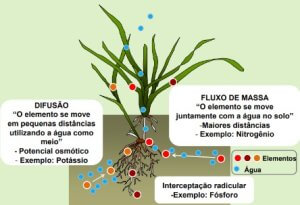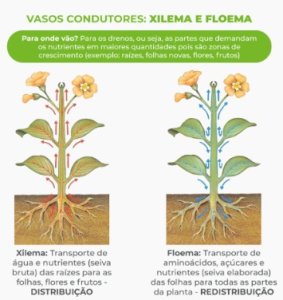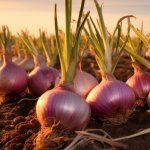Plants are autotrophic organisms, capable of living in an entirely inorganic environment, using CO2 from the atmosphere, water and soil nutrients. From the end of the 19th century onwards, extensive studies on the composition of plants grown in different soils made it possible to understand that the presence and concentration of a mineral element could not be criteria for demonstrating its essentiality. The plant absorbs mineral elements through its roots that are not always essential to its life and reproductive cycle, and has a limited selective absorption capacity, and can also absorb non-essential and/or even toxic elements (KERBAY, 2008).
Plant growth and development depend fundamentally on a continuous flow of mineral salts, which are essential for the performance of the main metabolic functions of cells. A plant will not develop and grow normally if it does not obtain a set of minerals and other essential elements that it needs. The supply and absorption of chemical elements required for growth and metabolism can be defined as nutrition, and the chemical elements necessary for an organism are called nutrients (BARROS, 2020).
To Kerbauy (2008). You essential mineral elements, also called mineral nutrients of plants, were discovered over time, and are those that meet the following three essentiality criteria:
- an element is essential when the plant cannot complete its life cycle in its absence;
- the element has a specific function and cannot be replaced;
- the element must be directly involved in the plant's metabolism, either as part of an essential constituent (e.g. an enzyme), or required for a specific metabolic step (e.g. in an enzymatic reaction).
To Barros (2020) nutrients are classified according to the amounts absorbed by plants:
- Primary or main macronutrients: Nitrogen (N), Phosphorus (P) and Potassium (K).
- Secondary macronutrients: Calcium (Ca), Magnesium (Mg) and Sulfur (S).
- Micronutrients: Boron (B), Chlorine (Cl), Copper (Cu), Iron (Fe), Manganese (Mn), Molybdenum (Mo) and Zinc (Zn).
- Non-essential elements: Sodium (Na), Silicon (Si) and Cobalt (Co).
In addition to these mineral elements, C, H and O are also essential chemical elements, which the plant extracts mainly from the air and soil, in the form of CO2 and of H2THE. These elements were grouped among the macronutrients.
Nutrients are important because they perform essential functions in plant metabolism, whether as a substrate (organic compound) or in enzymatic systems. In general, these functions can be classified as:
- structural (they are part of the structure of any organic compound vital to the plant);
- enzyme constituents (part of a specific structure, prosthetic/active group of enzymes);
- enzyme activators (not part of the structure).
It is important to emphasize that nutrients not only activate, but also inhibit enzymatic systems, affecting the speed of many reactions in the plant's metabolism (BARROS, 2020).
Mechanisms of contact between plant roots and soil
The supply of nutrients to roots growing in the soil depends on the physical and chemical attributes of the soil, the ionic species of the nutrient and the morphological and physiological characteristics of the roots.
Kerbauy (2008) describes that Plant roots come into contact with the soil solution from which they obtain the mineral nutrients they need. There are three mechanisms responsible for the movement of ions from the soil solution to the root surface: (1) mass flow; (2) root interception; and (3) diffusion (Figure 1).
- Mass flow is the movement of nutrients from the soil solution towards the root surface (rhizosphere); it is caused by the convective flow of water as it is absorbed by the plant. Water absorption, in turn, depends on the soil water reservoir and the plant's internal water potential, which is related to atmospheric conditions of temperature and humidity.
- THE root interception corresponds to the amount of nutrients that the roots find available in the rhizosphere as they develop, regardless of their movement in the soil.
- THE diffusion The transfer of nutrients from the soil to the root surface occurs when absorption by the plant is greater than the supply by the two mechanisms mentioned, creating a concentration gradient from the rhizosphere to the external environment. This concentration gradient causes the nutrient to move from the area of higher concentration to the area of lower concentration (rhizosphere). This is a complex process that depends on several soil factors, such as tortuosity (also called impedance factor) and temperature. Tortuosity varies with soil moisture, density and texture.

The relative importance of each of these mechanisms of nutrient movement from the soil to the plant depends on the ionic species involved, the plant genotype, the root density and the water flow in the plant. This means that the contribution of each mechanism of nutrient arrival at the root varies with the nutrient, the crop and the environmental conditions of the soil and atmosphere. For example, for corn, considering adequate fertilization for a production of 9,500 kg ha-1, the approximate amount of nutrients that reach the roots by root interception can vary from 1% (N) to 29% (Ca); by mass flow, from 5% (P), 71% (Ca), 79% (N), 87% (Mg) to 98% (S); and, by diffusion, from 20% (N) to 93% (P) (KERBAY, 2008).
In general, mass flow is the major contributor to the supply of Ca, Mg, N and S to the rhizosphere. Diffusion is more important for K, P and micronutrients. However, depending on the species and type of root system, mass flow may be equally or more important than diffusion in the supply of K to the roots. The morphological parameters of the roots (density, length and surface area) are very significant for the acquisition of nutrients from the soil by plants (KERBAY, 2008).
Mobility of ions and solutes in xylem and phloem
Xylem mobility
Nutrients absorbed by the roots are transported to the aerial part of the plants through the xylem, and between the organs of the plants through the phloem, although transport between organs can also occur via the xylem, to a lesser extent. The radial transport of the nutrient to the root xylem can have two components: one metabolic and the other non-metabolic. Through the metabolic pathway, the nutrient absorbed by the root is immediately incorporated into organic substances (acids or sugars) and transported and released into the xylem in organic or inorganic form, depending on the nutrient and the species. This is the case of phosphorus in young barley roots, which has a predominant metabolic mechanism of radial transport of P to the xylem (organic P), but it is released into the xylem in the form of inorganic P (KERBAY, 2008).
Most nutrients are transported to the shoot via the xylem in ionic (inorganic) form. NO may be present in the xylem in the form of nitrate, ammonium (in small amounts), amide or other amino acids, depending on the species and the form in which it was supplied to the plant. The other nutrients are found in the raw sap in large quantities in ionic form, but traces of organic compounds containing P and S may be found.
Phytohormones are normal constituents of xylem sap, particularly cytokinins, which are synthesized in the roots. The presence of abscisic acid (ABA) in raw sap has attracted great interest as a possible chemical signal from root to shoot about root hydration status. These root-derived hormonal signals affect the long-range transport of mineral nutrients by altering the volume of xylem flow, the rate of xylem-phloem transfer, and the distribution of mineral nutrients within the shoot (KERBAY, 2008).
Phloem mobility
Nutrient redistribution or remobilization occurs via the phloem (Figure 2), starting in the vacuoles of reserve tissues to the growing apical parts, together with the assimilates. When the plant detects the beginning of a lack of a nutrient at the apex (demand of the aerial part), a signal is sent, initiating the redistribution of the nutrient from the older leaves to the younger ones with greater or lesser speed, depending on their function and mobility. These characteristics are important in identifying deficiency symptoms, according to the part of the plant affected (KERBAY, 2008).

Thus, nutrients known as mobile move easily, and deficiency symptoms appear in older leaves. When the nutrient is part of cellular structures, such as walls and membranes, its mobility is restricted and deficiency symptoms appear in younger leaves.
Based on this location of deficiency symptoms in plants, the most well-known and accepted classification in the last decade, regarding mobility in the phloem, divided nutrients into:
- mobile – N, P, K, Mg and CI;
- little mobile – S, Cu, Fe, Mn, Zn and Mo; and
- real estate – Ca and B (Marschner, 1983).
What are the functions of nutrients in plants? Barros (2020) explains the function of the nutrients described below:
Macronutrients:
- Nitrogen (N) – It is essential for the formation of proteins, which are indispensable to the life of plants and animals and is part of metabolic compounds, such as chlorophyll and alkaloids. It is also part of many enzymes and vitamins and acts in all phases (growth, flowering and fruiting).
In addition to proteins, N acts in plant metabolism by directly participating in chlorophyll biosynthesis (TAIZ et al., 2017). In corn plants, for example, there is intense absorption of N in the initial stages of development, due to its intense metabolic activity (GONDIM et al., 2016).
- Phosphorus (P) – Acts on respiration and energy production, also acting on cell division, increasing it. It is part of reserve substances, such as starch and albuminoids. It facilitates flowering, increases fruiting and anticipates maturation, increasing the plants' resistance to diseases. It contributes to the growth of the root system and is a factor in quantity and quality in crops.
OP is found in organic and inorganic forms in the soil and it influences the development of the root system, acts on flowering, fertilization, formation and maturation of the grain (CARMO et al., 2014). In plants, phosphorus deficiency results in slower growth, reduced expansion of leaf area, number of leaves and stem diameter (TAIZ et al., 2017).
- Potassium (K) – This nutrient is used by plants to produce sugars and starch. It is essential for the formation and ripening of fruits, increases tissue rigidity and plant resistance to pests and diseases, and promotes the growth of the root system.
OK, after N, it is the nutrient most extracted by plants and is related to the photosynthetic process, it is an enzyme activator and acts in the translocation of assimilates to the leaves, opening and closing of stomata and osmotic regulation (ELMER; DATNOFF, 2014)
Secondary macronutrients:
- Calcium (Ca) – Helps to strengthen all plant organs, especially roots and leaves. It is a component of the plant cell wall and is necessary for maintaining the structure and activating amylase. It is also important in maintaining the balance between alkalinity and acidity of the environment and plant sap.
- Magnesium (Mg) – It is an integral part of the chlorophyll molecule and, therefore, is directly linked to the energy metabolism of plants.
- Sulfur (S) – It is mostly found in the composition of proteins associated with nitrogen. It participates in the formation of some amino acids essential for energy metabolism, and is involved in the synthesis of organic compounds, especially vitamins and enzymes, and is a nutrient that is very little mobile or even immobile.
ILSA fertilizers sources of macronutrients
ILSA Brasil has in its portfolio a complete line of fertilizers that provide macronutrients efficiently and in the appropriate quantities for different crops. The fertilizers in the GRADUAL MIX line® are obtained from the combination of the organic matrix AZOGEL® with mineral sources of phosphorus (P) and potassium (K), where AZOGEL® provides nutrients that reduce phosphorus fixation in the soil and potassium leaching, which allows plants to make better use of these nutrients. In addition, AZOGEL® It gradually provides organic nitrogen (N) and 16 essential amino acids for plant metabolism.
Another macronutrient source fertilizer that we can mention is S-TIME®. S-TIME® is obtained by combining AZOGEL® with elemental sulfur, which will be made available for absorption by plants more quickly since the AZOGEL matrix® It has nutritional elements that favor the biological activity of the soil, which increases the mineralization of elemental sulfur.
As a source of Calcium and Magnesium, the fertilizer ILSAMIN CaMg® from ILSA Brasil is obtained from the combination of the GELAMIN matrix® with mineral sources of calcium and magnesium. The presence of the GELAMIN matrix® rich in amino acids, they increase the speed at which these elements are absorbed by plants, preventing possible deficiencies more efficiently.
References:
BARROS, José. Soil fertility and plant nutrition. 2020.
CARMO, DL, et al. Growth of newly planted coffee seedlings: effect of phosphorus sources and doses. Coffee Science, Lavras, v. 9, n. 2, p. 196-206, 2014.
ELEMER, WH; DATNOFF, LE Mineral Nutrition and Suppression of Plant Disease. Encyclopedia of Agriculture and Food Systems, vol. 4, 231–244, 2014.
GONDIM, ARDO, et al. Initial growth of corn cultivar brs 1030 under nutrient omission in nutrient solution. Ceres, Viçosa, v. 63, n. 5 2016.
KERBAUY, Gilberto Barbante. Plant physiology. 2008.
TAIZ, L., et al. Physiology and Plant Development. 6. ed. 2017, p.858.
Authors:
Agr Eng. Dr. Angélica Schmitz Heinzen
Agricultural Eng. Msc. Carolina Custodio Pinto
Agricultural Eng. Msc. Thiago Stella de Freitas






